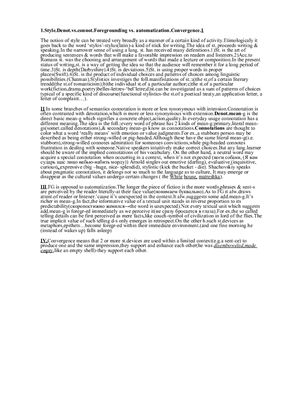The notion of style. Denotation vs. connotation. Foregrounding vs.
automatization. Convergence.
Types and sources of connotation.
Classifications of functional styles. The functions performed by each style.
The colloquial style. The two controversial tendencies which determine it. Slang as one of its features. The chief mechanisms of creating slang.
The poetic style. Poetic and archaic vocabulary (including historisms).
The oratorical style as the oral manifestation of the publicistic style. Name some kinds of oratorical dis-course. Examples of stylistic means, typical of oratory and frequent oratorical clichés.
The newspaper style. The syntactical and stylistic peculiarities of brief news items and headlines.
The style of official documents. Examples of official clichés with their equivalents in the target lan-guage.
The scientific style. Classification of terminology.
Classification of tropes. The components of a trope (tenor, vehicle, etc.)
Simile. Epithet.
Metaphor. Views of metaphor. Parts of speech that can be used metaphorically.
Metonymy. Personification.
Periphrasis: euphemism, dysphemism, political correctness, and – most important of all! - poetic (=художественный) periphrasis. The difference between periphrasis as a trope and paraphrasing.
Hyperbole and litotes. Unusual collocations. Oxymoron.
Intended ambiguity. Pun. Zeugma. Irony (including dramatic irony).
Antonomasia. Allegory as a trope and as a literary genre.
The use of phraseologisms. Allusion as a kind of set expression: sources of allusion. Use of allusion in the titles of literary works.
Decomposition of set expressions: its main mechanisms and functions.
Inversion as a syntactical means of creating connotation. Transposition of syntactical structures.
Compression as a group of syntactical devices creating connotation.
Repetition from the viewpoint of WHAT is repeated (= levels of repetition). Explain the effect.
Repetition from the viewpoint of HOW the repeated units are organized (pattes of repetition). Explain the effect gained.
Antithesis. Climax. Suspense. Enumeration.(Explain the effect gained.)
Phonetic stylistic devices: alliteration, assonance, onomatopoeia.
Phonetic stylistic devices: rhyme and rhythm (which, in syllabic verse, manifests itself as meter).
Graphical stylistic devices.
Types of narrative from the viewpoint of focalization. Represented speech as a manifestation of local focalization.
Time in fiction (density and direction).
Types and sources of connotation.
Classifications of functional styles. The functions performed by each style.
The colloquial style. The two controversial tendencies which determine it. Slang as one of its features. The chief mechanisms of creating slang.
The poetic style. Poetic and archaic vocabulary (including historisms).
The oratorical style as the oral manifestation of the publicistic style. Name some kinds of oratorical dis-course. Examples of stylistic means, typical of oratory and frequent oratorical clichés.
The newspaper style. The syntactical and stylistic peculiarities of brief news items and headlines.
The style of official documents. Examples of official clichés with their equivalents in the target lan-guage.
The scientific style. Classification of terminology.
Classification of tropes. The components of a trope (tenor, vehicle, etc.)
Simile. Epithet.
Metaphor. Views of metaphor. Parts of speech that can be used metaphorically.
Metonymy. Personification.
Periphrasis: euphemism, dysphemism, political correctness, and – most important of all! - poetic (=художественный) periphrasis. The difference between periphrasis as a trope and paraphrasing.
Hyperbole and litotes. Unusual collocations. Oxymoron.
Intended ambiguity. Pun. Zeugma. Irony (including dramatic irony).
Antonomasia. Allegory as a trope and as a literary genre.
The use of phraseologisms. Allusion as a kind of set expression: sources of allusion. Use of allusion in the titles of literary works.
Decomposition of set expressions: its main mechanisms and functions.
Inversion as a syntactical means of creating connotation. Transposition of syntactical structures.
Compression as a group of syntactical devices creating connotation.
Repetition from the viewpoint of WHAT is repeated (= levels of repetition). Explain the effect.
Repetition from the viewpoint of HOW the repeated units are organized (pattes of repetition). Explain the effect gained.
Antithesis. Climax. Suspense. Enumeration.(Explain the effect gained.)
Phonetic stylistic devices: alliteration, assonance, onomatopoeia.
Phonetic stylistic devices: rhyme and rhythm (which, in syllabic verse, manifests itself as meter).
Graphical stylistic devices.
Types of narrative from the viewpoint of focalization. Represented speech as a manifestation of local focalization.
Time in fiction (density and direction).

